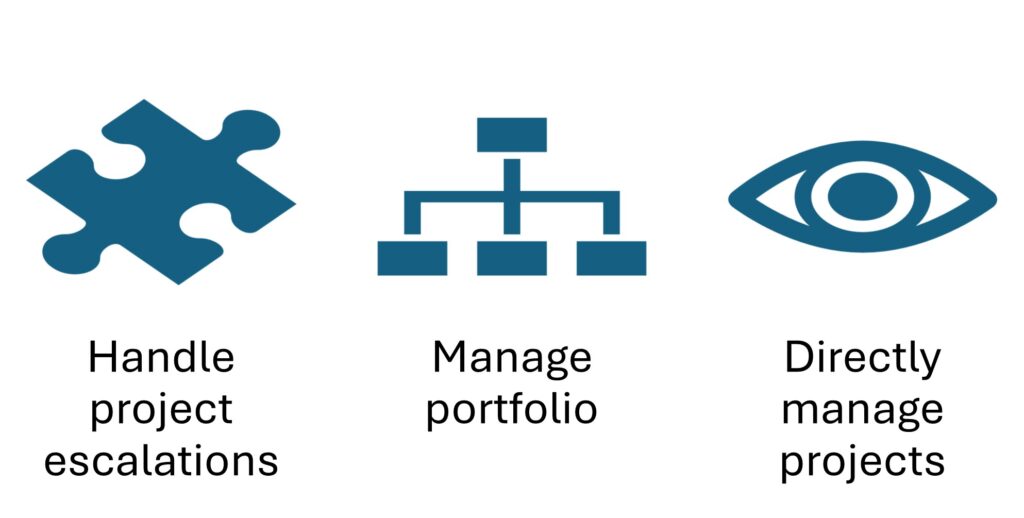Will this PMO flourish or fade?
Vanguard Solutions is struggling with a chaotic collection of projects that often run late, cost much more than expected, and disappoint customers. Tyra Frerichs, VP of Development, was just tapped by Vanguard’s CFO to spearhead a PMO that fixes this. Where should she start?
Tyra checked with her favorite AI chatbot, which told her that PMO is an acronym for Project Management Office. The bot said that an effective PMO can coordinate project activity across an organization. It also warned that hastily assembled PMO’s have a high dissatisfaction rate. Good ones increase efficiency, project successes, and bottom-line results.
Duly warned, Tyra did more research. She found that an effective PMO is not cookie cutter. It must be tailored to address the specific challenges that are important to its organization. She discovered six services that a PMO may choose to offer.
1. Be a center of excellence
A PMO that is a center of excellence is the organization’s repository for best practices and guidance about projects. In this scenario, the people running projects are usually external to the PMO. They may not be experienced or trained project managers; thus the PMO plays a key role assisting them with their projects.
A center of excellence may promote good processes and language about projects, as well as manage organizational knowledge such as lessons learned. It can provide support and coaching about projects to the rest of the organization and can be a home for specialists who are loaned as resources to external project leaders.
2. Set standards
Some organizations need more compliance than the advice that a center of excellence can provide. In this case, a PMO can set and enforce standards for how projects are run. Standards-setting PMO’s are responsible for the organization’s project management system. They may require the use of standardized practices, phases, checkpoints, or tools. Standardization, when done well, increases efficiency. Things don’t have to be invented from scratch for every project. Good practices get embedded into every project. Project managers can move more easily between different projects and get up to speed faster.
3. Provide visibility of all projects in the portfolio
A PMO that provides visibility is an unbiased single source of truth about projects. This style understands the “big picture” about projects across the organization. It is responsible for communicating that picture to decision-makers. The primary customers for this service are the functional and executive management teams.
This service provides information and insight to executives on the costs, value, and implications of the projects the organization is doing. It may also facilitate governance – the framework that enables management to make good decisions about projects.
4. Handle project escalations
A PMO can be the escalation pathway for the projects that are in the portfolio. When a project team can’t resolve issues outside of its scope, it may facilitate cross-functional problem-solving, move resources between projects, and make priority calls. Projects that are highly visible or complex tend to attract lots of management involvement. For these projects, the PMO can be the single point of contact for much of that involvement, helping everyone stay better informed, coordinated, and more efficient.
5. Facilitate portfolio management
Some organizations use project portfolio management (PPM) as a framework to manage a large collection of projects. Portfolio management selects and manages projects so that they support strategic goals, fit with the organization’s capability and resources, and coordinate with each other. PPM decision-makers are usually business unit executives outside the PMO, but the PMO is a natural choice to own PPM processes and facilitate executive involvement. This may include managing the pipeline of ideas for new projects, facilitating data-driven decisions on which ideas get promoted to active projects, maintaining an inventory of active and proposed projects and their status, and managing resource availability for projects.
6. Directly run or support specific projects
A PMO of this type directly leads high visibility or critical projects, managing them with experienced project managers who work directly for it rather than in other functional units. It may also provide targeted expertise and support to projects outside the direct management of the PMO. It may conduct in-depth reviews of the health and status of key projects, whether or not the PMO is running them directly.
What’s next? Set your PMO up for success.
A PMO that fails to deliver clear value will falter quickly, but one that is tailored to its organization can create many benefits. Tyra is determined to start Vanguard’s PMO on a good foundation, so her first step will be to ask its internal stakeholders what services they want from it. It won’t align exactly with the six categories above. It will be a custom variation that will be unique to Vanguard and will set it up for success.
I teach and consult about highly effective projects, portfolios, and leadership. You can contact me at [email protected].


